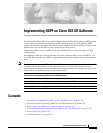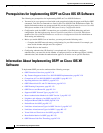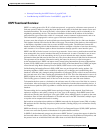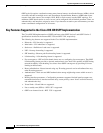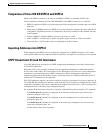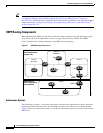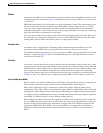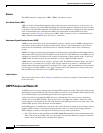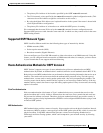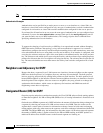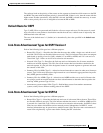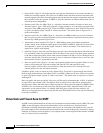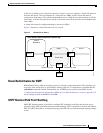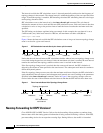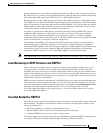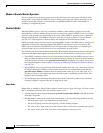
Implementing OSPF on Cisco IOS XR Software
Information About Implementing OSPF on Cisco IOS XR Software
RC-135
Cisco IOS XR Routing Configuration Guide
• The primary IPv4 address of the interface specified by the OSPF router-id command.
• The 32-bit numeric value specified by the router-id command in global configuration mode. (This
value must be an IPv4 address assigned to an interface on this router.)
• By using the highest IPv4 address on a loopback interface in the system if the router is booted with
saved loopback address configuration.
• The primary IPv4 address of an interface over which this OSPF process is running.
We recommend that the router ID be set by the router-id command in router configuration mode.
Separate OSPF processes could share the same router ID, in which case they cannot reside in the same
OSPF routing domain.
Supported OSPF Network Types
OSPF classifies different media into the following three types of networks by default:
• NBMA networks (POS)
• Point-to-point networks (POS)
• Broadcast networks (Gigabit Ethernet)
You can configure your Cisco IOS XR network as either a broadcast or an NBMA network. Using this
feature, you can configure broadcast networks as NBMA networks when, for example, you have routers
in your network that do not support multicast addressing.
Route Authentication Methods for OSPF Version 2
OSPF Version 2 supports two types of route authentication: plain text authentication and MD5
authentication. By default, no authentication is enabled (referred to as null authentication in RFC 2178).
Both plain text and MD5 authentication are performed on changed routing information that arrive on an
interface. The sender and receiver must know the authentication password or key. For both types of
authentication, a router sends a routing update packet with a key and corresponding key number. The
receiving router checks the key number and key against its own stored key number and key. If the key
numbers and keys match, the router accepts the routing update packet. If they do not match, the routing
update is discarded.
Plain Text Authentication
Plain text authentication (also known as Type 1 authentication) uses a password that travels on the
physical medium and is easily visible to someone that does not have access permission and could use
the password to infiltrate a network. Therefore, plain text authentication does not provide security. It
might protect against a faulty implementation of OSPF or a misconfigured OSPF interface trying to send
erroneous OSPF packets.
MD5 Authentication
MD5 authentication provides a means of security. No password travels on the physical medium. Instead,
the router uses MD5 to produce a message digest of the OSPF packet plus the key, which is sent on the
physical medium. Using MD5 authentication prevents a router from accepting unauthorized or
deliberately malicious routing updates, which could compromise your network security by diverting
your traffic.



